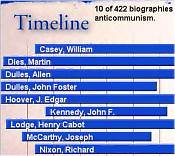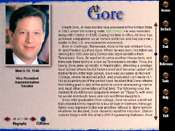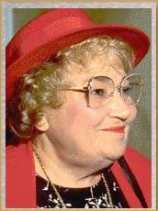
American Political Leaders.
Tim O'Donnell, Managing Editor.
ABC-CLIO CD-ROM, 1998. System Requirements: Windows 95, Windows 3.x, or Windows NT 4.0 (or higher), 486SX/33 MHz or faster processor, 16MB RAM, hard drive with at least 30MB free recommended, SVGA monitor (640 x 480, 256 colors), Windows-compatible mouse or pointing device, 2X CD-ROM drive, sound card (Creative Sound Blaster compatible) recommended.
American Political Leaders is a straightforward compilation of short biographies of political leaders, traditionally defined. Political Leaders includes all of the Presidents, unsuccessful candidates for President (from major parties), Secretaries of State, Speakers of the House, and Chief Justices through the current Clinton administration. This obligatory list consumes a large percentage, but not all of the 400-plus profiles. Selection of the remainder is heavily skewed towards the post-World War II period. The selection criteria are not self-evident. For instance, one can find several paragraphs about Bushrod Washington, appointed by John Adams to the Supreme Court, but no profile on Booker T. Washington. Martin Durkin, Eisenhower's Secretary of Labor is profiled, but not W. E. B. Du Bois. Bella Abzug appears, but not the influential advocate of maternalist social welfare programs, Grace Abbott.
The CD-ROM is geared towards a high school audience. Most entries are five to six paragraphs long and contain brief bibliographical notes. The entries focus on the subject's major political accomplishments and biographical milestones. Relatively few recent sources have been used in compiling these profiles. No effort is made to integrate these political leaders into a broader social or cultural context. The profiles will most likely be used by students who are looking to beef up the factual content of school reports. Despite the disproportionate emphasis on recent political leaders, text predominates. There is one still photograph for most leaders. There is no audio or visual material provided, despite its ready accessibility. The presentation of this material is as wooden as the selection criteria.
American Political Leaders makes no effort to integrate its profiles into a broader narrative. Nor is there any treatment along thematic or analytical lines. Instead, the CD-ROM provides rudimentary resources such as a glossary—where I could get details on Arnold Schoenberg's development of the twelve-tone technique of composition—and maps—I clicked on a map of Armenia. The text of the profiles contains links to relevant maps and related profiles. While some times useful, the selection of some links suggest that perhaps the CD-ROM is aimed at an audience far younger than high school age. For instance, click on "Wisconsin" in the profile of William Rehnquist and a map of that state appears. Click on "World War II" in the profile and a brief explanation of that war pops up. High school students might have been better served by links to important primary sources for each political leader or video or audio clips of them in action.
The closest that American Political Leaders comes to integrating this material is through a search engine that allows the user to do a text search. Such searches are slowed by the failure to highlight the word(s) searched for in the targeted text. Thus, the user must read through the entire entry in order to find the word he/she was searching for.
 |
Timeline. From American
Political Leaders. |
There is also a primitive timeline that superimposes, by pre-selected category through a bar graph, the life spans of subjects against a background of historical milestones. The timeline is of limited value for two reasons. First, the graph displays the subject's entire life, not the period that addresses the topic searched. Thus Richard Nixon is an "anticommunist" for much of the 20th-century, right-wing criticism of him for d�tente in the 1970s notwithstanding. Second, the "milestones" against which the topics displayed are measured are the same, regardless of topic. The one closest to Nixon's historic opening to the People's Republic of China is the Apollo 11 moon landing.
American Political Leaders deserves its own hyperlink in any discussion of the social construction of technology. It is a good example of the failure of imagination despite a medium that virtually begs for new approaches. It is also a potent reminder of the power of the march-of-Presidents approach to political history.
Brian H. Balogh
University of Virginia
~ End ~
CD-ROM Review of ABC-CLIO American Political Leaders
Copyright © 1999 by The Journal for MultiMedia
History
Comments
| JMMH
Contents
|


